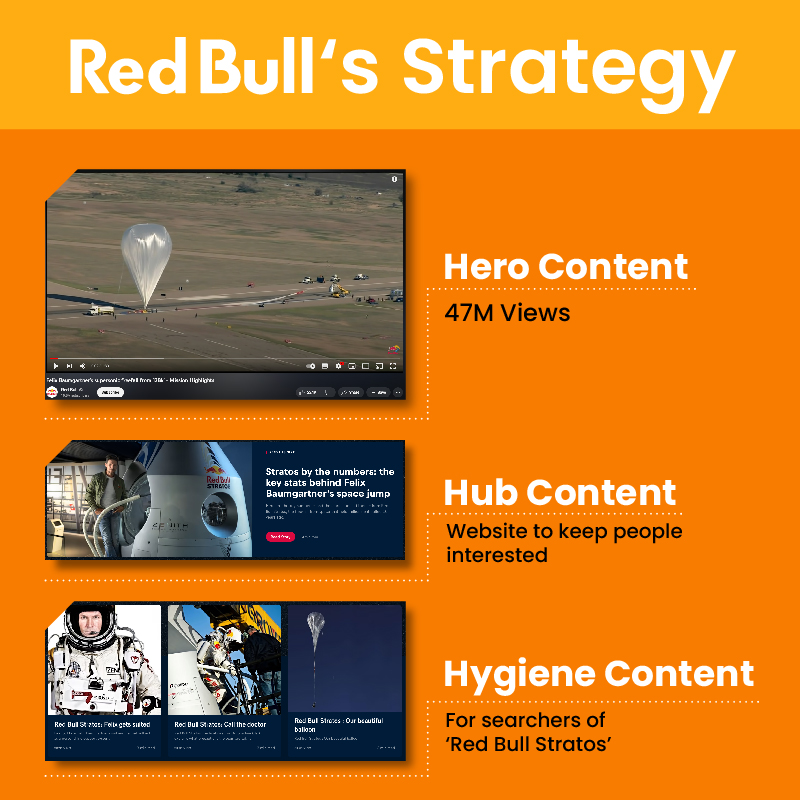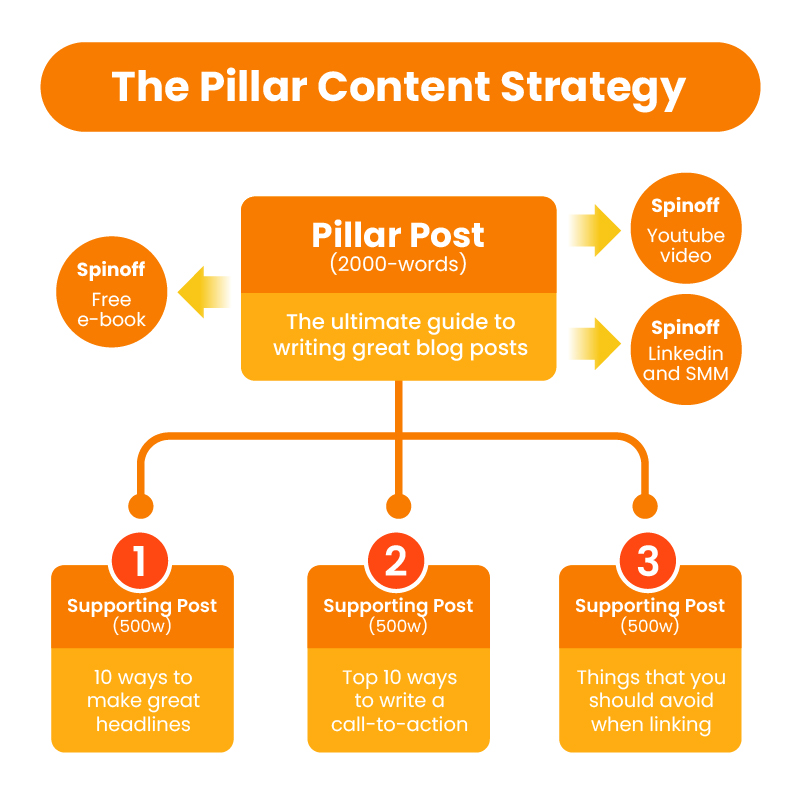

Content Strategies Compared

It’s not enough to simply create content and hope an audience finds it. Behind every successful piece of content is a well thought out content strategy.
When it comes to content strategies there are prominent approaches – the 4-1-1, hero-hub-hygiene, and pillar content.
How do you know which one will resonate with your audience? Let’s take a look at what’s good, what’s bad, and how your content strategy can help your audience through every step of their buyer’s journey.
The 4-1-1 Strategy
The 4-1-1 strategy is often cited for social media platforms, but can be applied for blog posts and other types of content. It works on a very simple principle that asks that you create six related posts revolving around a single topic per cycle (hence the number 411) – four curated posts that revolve around the theme, one hard-sell post and one soft-sell post.
Let’s take a look at how this works. For example, if you’re from a social media content marketing agency and the determined topic for this cycle is about creating video content on social media platforms, then you should create:
- Four posts reshared and curated from other content writers about different parts of the video production process. The purpose of this content is to educate and entertain.
- One post talking about your agency’s video production process and customer testimonials. The purpose of this content is to sell your product.
- One post talking about the importance of producing good videos and investing in a good video production company. The purpose of this content is to sell the problem your product solves.
The Pros and Cons
The main reason it works is because the content is focused without being too sales-y.
When creating content, our target audience often wants posts that add value and promote engagement. The issue with creating these is that the content cannot be too pushy – customers are often turned away by content that looks like an advertisement, and such posts are also unlikely to bring traffic to your website.
Using the 4-1-1 plan ensures that your audience gets the most value out of every topic and is exposed to your product as a solution without being overly sales-y or pushy.
However, it takes a lot of time and planning for each content cycle and is usually not feasible for companies with smaller content marketing teams. It’s also a rather long-term plan as not all posts will generate traffic – each blog post aims to do something specific rather than being all geared at increasing traffic.
Hero, Hub and Hygiene Content Strategy
The second strategy involves categorising pages and ideas into three types of content:
- The Hero: Go big or go home, large-scale, one-shot marketing piece or video targeted at the mass audience. It’s meant to be celebrated like a hero.
- The Hub: Core content that is meant to keep your audience continuously interested and coming back. This is generally in the form of a YouTube video with the purpose of enticing people to ‘like, follow and subscribe’.
- The Hygiene: Low-cost content types that leverage search engine results. It’s meant to be keyword focused and touches on anything that your brand is about that your audience can google for.
Here’s an example of the hero, hub, and hygiene strategy by Red Bull:

The Pros and Cons
This works because it focuses on building a community around your brand from the first stage of the buyer’s journey, and a well-thought plan could possibly go viral.
Looking at any successful viral campaign reveals why it works – the customer is first introduced through the sales funnel through either the hero or hygiene content, and then is constantly enticed to return with the hub content. Hub content is key here as it keeps the website or channel growing.
However, this is most effective on certain kinds of content – specifically, videos. With YouTube being one of the largest search engines today and videos being one of the most shareable content formats, this strategy is best suited if your business revolves around your content creation, or if it’s focused around community building through videos.
Not the best if applied to written content, so it’s best to do your own evaluation.
Pillar Content Strategy
Despite all the different strategies, 75% of B2B marketers still believe that a blog is the most effective at generating awareness, and articles are the most important piece of content to be produced for any business.
There are two types of blog posts that can be published: pillar content and supporting content. Pillar content, as the name suggests, refers to high-impact, long-form content of 2000 words and above that act as the centrepieces of your website’s blog. These generally will be the pages that your audience lands on when they search google. These will then be supported by shorter, supporting articles that go into subtopics in the pillar in-depth.
An example of a pillar content structure:

The Pros and Cons
This works because it can not only develop reader interest throughout the buyer’s journey, but also because this method is evergreen – there’s essentially no expiry date on the content you produce if information isn’t outdated.
In turn, pillar content like a ‘how to’ or ‘ultimate guide’ article can be spun off and developed into other content formats, such as a free e-book people can download, or a free resources, tool or template for others at different points in your sales funnel.
The disadvantage, obviously, is the amount of research and familiarity with the industry that you’re in. Not only will you need to do an in-depth keyword search, but you’d also have to create content that is not only relevant to your business, but also specific pillar posts and structures. In addition, SEO efforts take time to realise and require more resources, and is a long-term approach rather than short-term.
However, if you can develop quality content that’s SEO optimised, the potential payoff for your target audience is immense in the long run.
So…
Whether you’re doing social media marketing or content writing in your industry, or if you’re a marketer yourself, there are many, many structures, and plans for creating new content.
We’ve touched on three approaches to content strategy, but it really depends on your market and, honestly, guts and dedication in deciding what’s the best approach for you and your business.
Our advice to you?
Research, start, and press on.
Developing a content strategy isn’t a one size fits all process. Each business is different and requires a different approach to connecting with its customers. Click2View are a team of storytellers who understand how each piece of content works together.
Read more from Click2View:
- Five Reasons Newsletters Still Work
- Kill Your Darlings, They’re Just Words
- Deepfakes, Elon, and the Future of Celebrity Endorsement
- Writing and Illustrating with an AI
Sign up to our newsletter for a weekly update on the latest content marketing news. Don’t forget to subscribe to our YouTube channel too!
Click2View is Southeast Asia’s premiere full-service independent B2B content marketing agency servicing clients like Microsoft, Google, Visa, Prudential, and the Lee Kuan Yew School of Public Policy.








